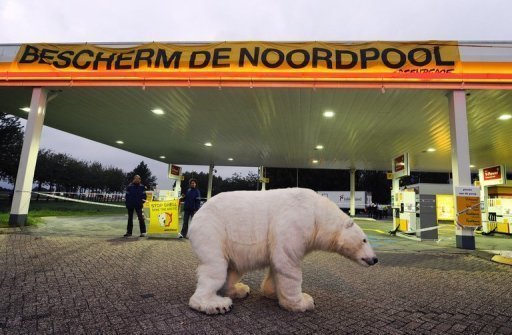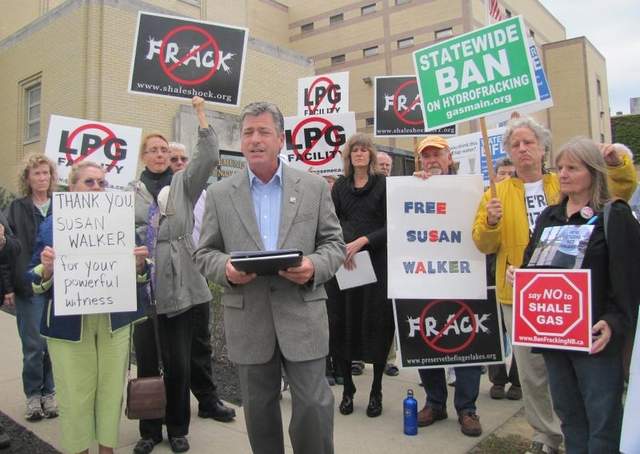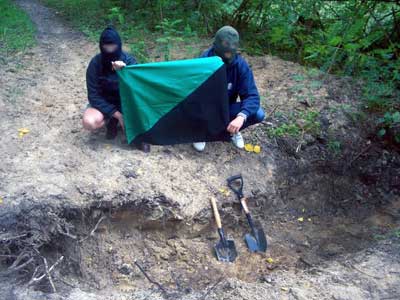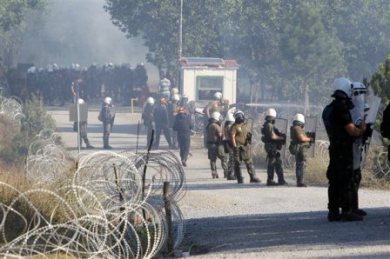Following the attack, military helicopters began flying over the resisting communities, “like in the old days of the armed conflict.” 
 On September 17 and 18, community members from Mataquescuintla, Jalapa and San Rafael Las Flores, Santa Rosa, Guatemala protested against the ongoing development of a mining project in their communities. In response to the first of these protests, provocateurs attacked both police and community members with stones. In response to a peaceful blockade outside the mining site, protesters were “attacked without warning by members of the mine’s private security agency, the National Civil Police and the army, using tear gas cannons, firearms and rubber bullet guns. Security agents attacked from inside the mine, with trained attack dogs. The Police cornered the unarmed protestors, and the army surrounded them, crouched and at the ready. The display of repressive force had all the characteristics of military counter-insurgency tactics that we had thought belonged to the past, including the bad intentions, brutality and cowardice that so characterize the tactics of the National Army.”
On September 17 and 18, community members from Mataquescuintla, Jalapa and San Rafael Las Flores, Santa Rosa, Guatemala protested against the ongoing development of a mining project in their communities. In response to the first of these protests, provocateurs attacked both police and community members with stones. In response to a peaceful blockade outside the mining site, protesters were “attacked without warning by members of the mine’s private security agency, the National Civil Police and the army, using tear gas cannons, firearms and rubber bullet guns. Security agents attacked from inside the mine, with trained attack dogs. The Police cornered the unarmed protestors, and the army surrounded them, crouched and at the ready. The display of repressive force had all the characteristics of military counter-insurgency tactics that we had thought belonged to the past, including the bad intentions, brutality and cowardice that so characterize the tactics of the National Army.”
Mining Company and Government Thugs Attack Guatemalan Mine Resisters
Energy Industry Crackdown, Global Protest Frackdown
Yesterday, while Shell announced suing Greenpeace International in an attempt to have the organization banned from protest within 500 meters of any Shell property in the Netherlands, New York activist Susan Walker was sentenced to 15 days in jail after she refused to pay a fine for blocking the entrance to Inergy gas facility in New York earlier this month.
But judges and jails aren’t enough to stop a world-wide movement against the energy empire, and today marks the “Global Frackdown” with more than 100 protests against gas fracking scheduled to take place around the world. So get out there in the streets and raise some hell…
Shell sues Greenpeace to block environmental protests in the Arctic
The suit against Greenpeace Int’l argued at Amsterdam’s District Court Friday showed Shell aggressively taking the offensive to protect its $4.5 billion investment in drilling for oil in the icy Arctic waters off the coast of Alaska. A verdict is not expected for two weeks.

A protest at a Shell gas station in the Netherlands — with stuffed polar bear. (AFP/ANP, Marcel Antonisse)
Greenpeace has protested Arctic drilling with other stunts around the world, but the trigger for Friday’s lawsuit was a Dutch demonstration on Sept. 14, in which Greenpeace protesters blocked more than 70 Shell gas stations in the Netherlands for several hours, draping banners and clamping gas pump handles together with bike locks.
Fifteen people were arrested. Shell has not put forward any estimate of how much damage it suffered.
“Because Greenpeace International doesn’t operate alone, but is the spider in the web of national and local organizations, our request includes that Greenpeace inform its satellite organizations that it no longer supports protests that are solely directed at causing Shell economic damage or that bring human lives and the environment in danger,” Shell’s complaint said.
Protest backs jailed environmental activist in Inergy Blockade

Joseph Campbell, president of Gas Free Seneca, speaks Friday outside the Chemung County Jail. He said local residents turned to civil disobedience because their petitions, letters and attending hearings failed to get their voices heard on Inergy Midstream’s proposed storage facility.
Nearly 30 people slammed the energy industry outside the Chemung County Jail on Friday but praised the Dundee woman held inside for refusing to pay a fine for trespassing at a proposed gas storage facility.
They demonstrated in support of Susan Walker, 53, who pleaded guilty to trespassing Wednesday night before Reading Town Justice Raymond H. Berry and got 15 days in jail after she refused to pay the $275 fine.
“We’re in agreement with Susan’s words when she spoke in the courthouse, ‘If I were a corporation, I would not be going to jail,’” said one of four speakers, Sandra Steingraber, an Ithaca College scholar in residence who co-founded the coalition New Yorkers Against Fracking.
Fracking Protests Planned Around The World By GlobalFrackdown Campaign
More than 100 protests against the natural gas drilling process known as fracking are scheduled to take place around the world on Saturday, building on public concerns but also using an overly simplified message to spur outrage.
The GlobalFrackdown website and campaign was developed by Food & Water Watch, a Washington, D.C. nonprofit that was once part of Ralph Nader’s Public Citizen group. The campaign claims that fracking “has already damaged communities and ruined lives. It pollutes water and makes people sick.”
(USA) Another Lockdown Against the Keystone Tar Sands Pipeline!


Protesters locked to equipment clearcutting forests to make way for the Keystone tar sands pipeline. Winnsboro, TX, Sep. 19 2012
Tar Sands Blockade protesters have locked themselves to a wood chipper and skidder being used to clear-cut trees near Winnsboro, TX to make way for the Keystone XL tar sands pipeline. This is the fourth action to date in the Tar Sands Blockade campaign.
The Tar Sands Blockade campaign is active and ongoing. Calls to join the action have been put out both by the main group and by “a small crew of Earth First!ers and eco-anarchists engaged in tactical elements of the larger Tar Sands Blockade campaign.”
To find out more, watch this Tar Sands Blockade action video, and visit tarsandsblockade.org and stoptarsands.org.
(India) Police Kill Anti-Nuke Protester in India, Resistance Continues to Grow


A group of fisherfolk staging “jal satyagraha” in the sea, against the Kudankulam nuclear power project at Veerapandianpattinam coast in Tuticorin district on Friday. (Photo: N.Rajesh)
Despite the killing of an anti-nuclear protester by police on Monday, hundreds of protesters forming a human chain stood in sea waters today, for the second day in a row, demanding a halt to preparations for fuel loading into the reactor of Kudankulam Nuclear Power Project (KKNPP) in Tuticorin district.
The Hindu.com reported that women and men would stand in the sea waters for two hours in turns. Pushparayan, leader of the People’s Movement Against Nuclear Energy (PMANE) has been spearheading the year-long agitation.

Indian police officers detain a protestor after they baton charged residents protesting against the Russian built Kudamkulam nuclear plant on the Bay of Bengal coast at Kudamkulam, Tamil Nadu state, India, Monday, Sept. 10, 2012. (AP Photo)
The Coast Guard aircraft and ships maintained surveillance at sea off nearby Idinthakarai as the villagers stood in waist and neck deep water.
Taking cue from a similar protest demanding land as compensation and reduction of Omkareshwar Dam recently by villagers of Khandwa district in Madhya Pradesh, PMANE launched their jal satyagraha (water civil disobedience) on Thursday, marking a new turn in their agitation, which was intensified after preparations for fuel loading into the plant was announced.
More than 4,000 police personnel, bolstered by the paramilitary Rapid Action Force, continued to maintain a strict vigil, having almost sealed the entire Kudankulam town.
Meanwhile, police have been seeking to arrest S.P. Udayakumar, the convener of PMANE, in attempt to quell the protests. They have already arrested a close associate of Udayakumar in Chennai last week for trying to “instigate” the fishermen to join the stir against Nuclear Power Project.
Mr. Udayakumar had allegedly announced that he would surrender on Tuesday night, but seems to have changed his mind. Police said they would continue their search.
Earlier this week, state officials say Indian police fired at protesters near this nuclear power plant being constructed in southern India, killing one person.
The Tamil Nadu state government says police fired Monday to disperse about 2,000 people who were demonstrating against the loading of nuclear fuel in the Russian-built reactor. It says the protesters threw stones and sticks at police near the Kudankulam Project, and five officers were injured.
Construction of the plant has been delayed by protests in the past year by residents and anti-nuclear groups concerned about safety following the Fukushima nuclear power plant disaster in Japan last year.
The government says the plant, about 700 kilometers (440 miles) south of Chennai, the state capital, will meet safety standards.
The following video shows recent coverage of the jal satyagraha actions against hydroelectric dams which have become an inspiration to movements throughout the region:
USA: Protesters Blockade Monsanto Seed Facility in California
The protesters, who want to remove all so-called genetically modified organisms (GMOs) from the food supply, say their action is a preview of about five dozen other events planned for countries around the world next week. Monsanto and other developers of these biotech crops say they are safe. But U.S. regulators do not require any independent safety tests that would put a lid on doubts raised by consumers and some scientific and health groups. More than 40 countries around the world have some requirements for labeling foods containing ingredients from genetically modified crops. But U.S. regulators have rejected requests by many groups for similar labeling rules, and as a result many Americans do not know that they have been eating GMOs for years. At the protest on Wednesday, about a dozen people organized by a network of anti-GMO activists called Occupy Monsanto stopped trucks from entering or leaving Monsanto’s Oxnard, California-based Seminis for nearly six hours. The activists, some dressed in biohazard suits, blocked truck entrances with cars and chained themselves to the vehicles. Police arrested nine of the protesters and charged them with trespassing, organizers said. Seminis’ biotech sweet corn is one of the newest GMO crop products to make it to market. The corn was altered genetically to withstand dousings of a common weedkiller and to ward off certain pests. “We deserve to know what we are eating and we should put GMO crops back in the lab and off the kitchen table,” protester Rica Madrid said. Occupy Monsanto is not affiliated with the backers of a California proposal to label foods that are made with crops or from animals that have had their genetic makeup altered in the laboratory. Monsanto did not directly address Wednesday’s events but said the company’s work helped improve farm productivity and food quality. “We respect each individual’s right to express their point of view on these topics,” Thomas Helscher, a Monsanto spokesman, said of the Seminis protest. DIFFERENT VIEW IN EUROPE GMOs are deeply unpopular in Europe and many other countries, but they eventually came to dominate key crops in the United States after Monsanto in 1996 introduced a soybean genetically altered to tolerate Monsanto’s Roundup weed killer. Using genes from other species, Monsanto and rivals including DuPont and Dow Chemical have since introduced an array of genetically altered crop varieties. The most popular genetically engineered crops in the United States include corn, soybeans, sugar beets and canola – staple ingredients in a wide array of popular packaged foods. Proponents of GM crops say they make farming more efficient by making plants resistant to pesticides, pests and harsh growing conditions, such as drought. They say genetically modified crops are no different from conventional types and that increasing demand for food, biofuels and livestock feed can only be met with help from the biotech industry that Monsanto dominates. Critics say GM crops have not always lived up to their promise and that the benefits to farmers do not outweigh myriad risks to human and animal health and to the environment. Assessing such risks is difficult in the United States. The government does not require GMO crops to undergo independent safety testing before they are approved, and it does not require labeling for GMO content which makes it next to impossible to track any links to human health problems. The World Health Organization says “individual GM foods and their safety should be assessed on a case-by-case basis.” Recently, some U.S. scientists have raised alarm bells over what they see as potentially dangerous implications from overuse of GMO crops. Among the concerns is the fact that the rapid adoption by U.S. farmers of genetically engineered corn, soybeans and cotton has promoted increased use of herbicides, which critics say has triggered an epidemic of herbicide-resistant weeds and more chemical residues in foods. This week, the Center for Food Safety vowed to sue the U.S. government if it approves a new type of genetically altered corn developed by Dow. Community members in Canaan de Cachiaco Community members in Canaan de Cachiaco By: Ronald Suarez, President of the Network of Peruvian Indigenous Communicators, Ucayali *Correction: Maple Energy is a company listed in London and Lima, Peru. It is not a Canadian company. Over 400 villagers in the Native Community of Canan de Cachiaco in the Ucayali region of the Peruvian Amazon have taken control of nine oil wells, belonging to oil company, Maple Gas, in oil lot 31B. Community members took over the oil wells on September 2nd, and continue to hold them as a result of 37 years of oil contamination in their territory by the company. The community leader, Basilio Rodriguez Venancio, said the action was made necessary because the company did not consider the environmental impact assessment carried out by an independent consultant. One of the oil wells occupied by members of the Canaan de Cachiaco community in the Peruvian Amazon, September 2012 The community is demanding that the company pay them compensation for the use of their lands and for the environmental damage they have suffered for 37 years. Such damage includes the contamination of their rivers, their only source of drinking water, and the contamination of their soils due to the company´s use of chemicals and heavy minerals, which the population says has significantly affected the productivity of their land. Several community members testified that they have become sick due to the company’s negligence and contamination of their drinking water. There have been several instances in the past years of cancer and ¨unknown deaths¨ that the community attributes to company abuses. The community awaits the arrival of state representatives from the Ministry of Energy and Mines and Ministry of Environment, scheduled for Thursday, September 13th, to resolve this conflict. Meanwhile the villagers are still stationed in the camp until authorities settle their claims. For more information on the case of Canaan de Cachiaco, and the neighboring community, Nuevo Sucre, watch this video. September 10, 2012 received anonymously: "Kiev. Roads sabotaged in sanctuary. September 10, 2012 received anonymously: "Kiev. Roads sabotaged in sanctuary. On the night of 08.09 Kiev eco-activists dug a trench cutting the only road that led to the sanctuary 'Zhukov Ostrov', a habitat of several rare species of animals. Hundreds of protesters have battled riot police for hours over plans for a gold mine in northern Greece’s Halkidiki peninsula. Police fired tear gas to fend off protesters who had gathered in the Skouries area of Halkidiki, northern Greece, on Sunday to protest gold mining activity. Dozens of residents of the nearby village of Ierissos, as well as protesters who arrived by coaches and cars from Thessaloniki, approached the forest in Skouries, where Hellenic Gold, a subsidiary of Canadian firm Eldorado Gold, has begun mining activity that locals are appealing against. Protesters accused the police of making heavy use of tear gas, causing a fire in the woods, and of chopping down trees to prevent demonstrators from approaching the mine. Police say protesters threw firebombs at them, setting ablaze a forested area on the site. Either way, the fire has been put out. There were reports of several people being arrested and detained at Ierissos police station. Several people were also injured, including SYRIZA MP Vangelis Diamantopoulos. Hellenic Gold has been awarded an area of 26,400 hectares, of which 410 is forest land. Almost all the trees in the forest will be cut down as part of the mining firm’s plan to extract gold. The company says it will replant trees when it finishes its work. Environmental opponents of the mine argue it would lead to the destruction of the local forest and irreversible damage to the ecosystem. Owners of local tourist lodging are also fiercely opposed due to environmental reasons. This is not the first clash over the gold mine. Opponents succeeded a decade ago in canceling a multimillion-dollar gold mining project in a nearby area. Source The film below, Treasure Hunt, documents that struggle. This is the first 10 minutes of the film: The entire documentary with subtitles can be found online by clicking this link. “Spectra Showdown” protest against fracking in New York City, Sep. 6, 2012 “Spectra Showdown” protest against fracking in New York City, Sep. 6, 2012 “Today [Sep 6] the ongoing protest called “Spectra Showdown,” [in New York City]has finally turned into the scene of civil disobedience that the group has been anticipating. At least two people have been reportedly arrested. “After pre-construction in July, Spectra Energy begins a new phase of construction today that has involved shipments of materials on a barge on the Hudson and from the West Side Highway. Spectra hardhats were seen on people digging at 8:30 this morning right next to the bike path while protesters gathered next to them. A barge with a crane was on the River. The protesters held banners but it wasn’t until after 10 AM that it was tweeted that two were arrested. “The protest has been against hydrofracking (a process being used to drill for natural gas in the Marcellus shale fields of Pennsylvania and the general bioregion).” Three activists from Tar Sands Blockade locked themselves to construction equipment near Saltillo, TX this morning, shutting down the construction site completely. Three activists from Tar Sands Blockade locked themselves to construction equipment near Saltillo, TX this morning, shutting down the construction site completely. As of the latest update, workers and police had all left the site, leaving the blockade intact. The action is the third so far for Tar Sands Blocakde, a group devoted to stopping TransCanada’s plan to expand the Keystone XL Pipeline to transport oil from the Alberta Tar Sands to Texas. It follows only days upon an August 28 action, when four activists locked themselves to the underside of a truck actually carrying a piece of the planned pipeline. A total of seven protesters were arrested, but not before all Keystone construction transportation for the southern segment was shut down for a full day. In an unrelated action targeting big energy infrastructure, more than 150 protesters from Everglades Earth First! and Occupy Wall Street blockaded the access roads to TECO’s Big Bend coal plant on the eastern shore of Tampa Bay, FL on Aug 31, coinciding with the last day of the Republican National Convention in Tampa. According to a press release, “Earth First! activists chose this day for their protest in order to highlight Mitt Romney’s plan to expand what the group calls the “energy empire” which favors the interest of big donors in oil, gas and coal industries.” TECO was also chosen for its involvement in mountaintop removal coal mining. The plant was successfully blockaded for nearly four hours. Seven people were arrested. And as a bonus: the action led freaked-out authorities to temporarily shut down the Port of Tampa!Opponents of genetically engineered foods blocked shipments and deliveries yesterday at Monsanto Co’s vegetable seed company that developed a new genetically modified sweet corn that will hit stores this fall.
 They also hope to drum up support for a California ballot measure that would require food sellers to label a broad range of products, including soup, soy milk, breakfast cereals and chips, that contain GMOs.
They also hope to drum up support for a California ballot measure that would require food sellers to label a broad range of products, including soup, soy milk, breakfast cereals and chips, that contain GMOs.Indigenous Peruvians Occupy 9 Oil Wells



road sabotaged to protect wildlife reserve, Ukraine


Kievan middle and upper class has developed a bad habit of using SUVs for weekend hikes to forests and riverbanks.
The act was an attempt to make such kind of communion with nature more difficult."Protesters in Greece Clash with Police Over Gold Mine, Again
Five Arrested in New York Anti-Fracking Sit-In


Flurry of Anti-Fossil Fuel Direct Actions






